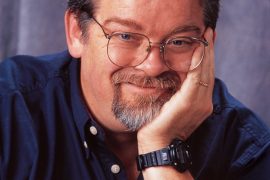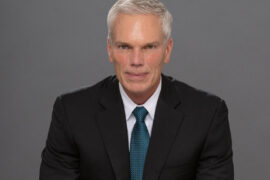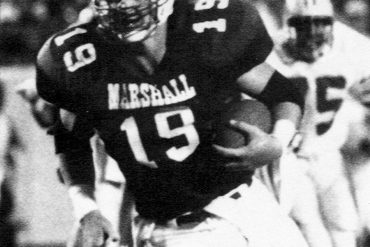By James E. Casto
HQ 66 | AUTUMN 2008
According to Webster’s Dictionary, a postcard is “a rectangular piece of thin cardboard intended for writing and mailing without an envelope.” That’s true, of course. But a postcard can be more – much more – than that.
In today’s era of e-mail, voicemail and cell phones, it’s easy to forget that Americans once sent millions of postcards every year. Fortunately for those of us who love local history, people not only liked to send and receive postcards, they liked to save them as well. Vintage picture postcards, retrieved from the attic where they they’ve been stored in Grandpa’s old steamer trunk or Aunt Sally’s hatbox, can yield fascinating glimpses of yesterday.
Thus, this postcard portfolio offers us a mirror to Huntington’s past, reflecting what life was like in our town, not so very long ago.
This undated postcard offers a good view of the Huntington skyline as seen from Chesapeake in Ohio, but it offers an even better view of the old Sixth Street Bridge. Opened in 1926, it would be the city’s only Ohio River bridge until 1968. The old two-lane span continued to carry traffic until 1993, when it was replaced by the four-lane Robert C. Byrd Bridge.

Here’s a colorful postcard of an early C&O passenger train, once a familiar sight in Huntington. The card is undated but a penciled message on the back suggests it may have been written during the World War I era. In the heyday of rail passenger service, thousands of Huntingtonians traveled aboard the C&O’s fancy George Washington and its other passenger trains.

The C&O’s first passenger station in the newly created town of Huntington was built in 1872, even before the rail line was completed between Huntington and Richmond, Virginia. This card, postmarked in 1911, offers a good view of the ornate structure. In 1913, the C&O erected a new Huntington station that its corporate successor CSX Transportation continues to use for offices.

Huntington’s Union Bank and Trust Co. originally occupied a small frame structure on the corner of Fourth Avenue and Ninth Street. In 1924, the bank replaced it with this handsome building, at that time the tallest in West Virginia. In 1943, the bank failed and its former home was renamed the West Virginia Building. Today, it houses a mixture of offices and apartments, with retail shops on the ground floor.

Even before Collis P. Huntington established his namesake city, logs were floated down the Guyandotte River to Guyandotte, a village that in 1911 would be absorbed into the growing Huntington. At Guyandotte, the logs – some as big as 70 feet in length and 4 feet in diameter – were sorted, measured, paid for and readied for the nearby sawmills. Those not sent to the local mills were lashed together and floated on down the Ohio River.

For decades this coal tipple, built on the Ohio River at Huntington in 1906, was the last stop for long trainloads of coal hauled westward by the C&O from the Island Creek Coal Company’s mines in Logan and Mingo Counties. (Note the card caption’s misspelling of the word “Fuel” in the company’s original name.) The old tipple was demolished long ago. Today, only the concrete piers remain.

In 1911, when the city fathers in Huntington purchased a site for a new City Hall, they paid the then-unheard-of sum of $48,000 for it. The King Lumber Company of Charlottesville, Virginia, won the construction contract with a bid of $115,380. Verus T. Ritter was the architect. City Hall is at the center of this postcard, with the Cabell County Courthouse at left and the Sixth Street Bridge in the background.

This card was never mailed so has no postmark to help date it. It was issued sometime between 1905, when the city’s U.S. Post Office was erected, and 1915, when the Civil War statue at left disappeared, a local mystery never solved. Two additions built to the west of the Post Office, in 1917 and 1937, stretched the building to nearly a block in length. Today, the city’s main Post Office is in West Huntington but the original Post Office building continues to house the U.S. District Court and various federal offices.

It was 1929 when “Floyd” mailed this postcard to his folks back in Ohio. The view of Third Avenue looking east from Ninth Street shows crowded sidewalks, lots of Model Ts and other automobiles and, of course, a number of retail stores, including the Anderson-Newcomb Co., a household name to generations of local shoppers. Today the buildings on the left are long gone, now replaced by Pullman Square.

Delos W. Emmons was Collis P. Huntington’s brother-in-law and his right-hand man in Huntington. Somewhere between 1910 and 1912, his son, Arthur S. Emmons Sr., built this apartment building at Third Avenue and Twelfth Street. In the city’s early years, the building housed many of its leading residents. In 1924, Arthur S. Emmons Jr. built another apartment building next door, naming it the “Emmons Jr.” In 2007, a tragic fire at the Emmons Jr. claimed nine lives and forced the demolition of both buildings.

Built at a cost of $400,000, Huntington’s grand Hotel Frederick opened in 1906. A mammoth project, its construction is said to have required 3.5 million bricks; 4,000 electric lights; 282 miles of electrical wire; 200 telephones, and 5 railroad cars of glass. This postcard was mailed in 1924, when the Frederick was clearly the city’s finest hotel. It ceased operation in 1973. Today, the building houses stores, offices and apartments.

Huntington’s First Presbyterian Church is one of more than a half dozen churches located within a few short blocks of the city’s Fifth Avenue. It traces its roots to 1838 when 18 Cabell County residents first met in the then-unfinished chapel at Marshall Academy. In 1872, a small church was erected at the rear of the church’s present Fifth Avenue location. The first worship service in the current sanctuary was held on September 20, 1896.

Huntington High School was designed by architect Verus T. Ritter, who also designed Huntington City Hall and a number of the community’s other best-known buildings. The school welcomed its first students on September 4, 1916 and continued in use until 1996, when it was merged with Huntington East High School into a new consolidated school. Today, the old building has been preserved and revamped for use as a community center.

Marshall University’s oldest and best-known building, Old Main (at left), actually is five different structures erected at various times. The familiar front of the building is the newest part, built in 1905-06. At right is Marshall’s second building, Northcott Hall. Built in 1916, it was demolished to make way for the 1998 construction of the school’s John Deaver Drinko Library.

Fairfield Stadium was built in 1928 on a South Side tract of land that once was a garbage dump. The red-brick stadium, a joint venture of Marshall, the Cabell County Board of Education and the Huntington Board of Park Commissioners, served well for many years. But as old Fairfield steadily deteriorated, Marshall football fans longed for a new, larger stadium. In 1991, the fans finally got their wish when the school opened its new $30 million stadium.

Steel tycoon & philanthropist Andrew Carnegie built hundreds of libraries in cities across the nation, including Huntington. Opened in 1904, the library on the corner of Fifth Avenue and Ninth Street served generations of readers until 1980, when a new modern library was erected just across the Ninth Street plaza.





